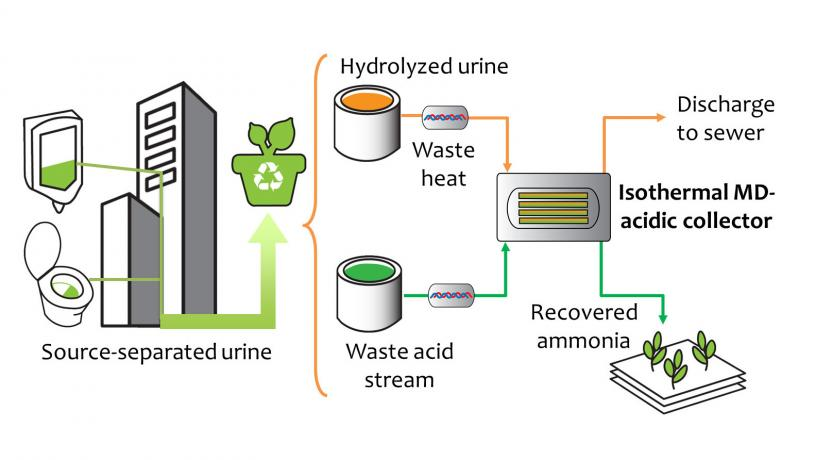May 7 2020
Ammonia is an essential component of fertilizer and it plays a crucial role in assisting plant growth and ultimately offers food for populations worldwide.
 Urine, which contains most of the nitrogen excreted by humans, can be isolated at the source via dry urinals and urine-diversion toilets. Through isothermal MD, volatile ammonia in hydrolyzed urine is driven across a hydrophobic microporous membrane where it is recovered as an ammonia fertilizer product in the acidic collector stream. The remaining urine can then be discharged to the sewer. Image Credit: Ngai Yin Yip and Chanhee Boo/Columbia Engineering.
Urine, which contains most of the nitrogen excreted by humans, can be isolated at the source via dry urinals and urine-diversion toilets. Through isothermal MD, volatile ammonia in hydrolyzed urine is driven across a hydrophobic microporous membrane where it is recovered as an ammonia fertilizer product in the acidic collector stream. The remaining urine can then be discharged to the sewer. Image Credit: Ngai Yin Yip and Chanhee Boo/Columbia Engineering.
However, ammonia is a major pollutant that, after being utilized in the food chain, reaches municipal wastewater treatment plants, wherein it is not removed properly. Then, it is released into the surroundings, contaminating aquatic settings and causing harm to the ecosystems, causing fish kills, dead zones, and detrimental algal blooms.
In the 21st century, ammonia capture has turned out to be a difficult challenge, particularly as the populations in cities are expected to increase drastically, with an estimated urban growth of 2.5 billion people by 2050.
Meanwhile, offering better sanitation to 2.3 billion people who are presently unserved worldwide will require the installation of wastewater facilities, new toilets, and sanitation infrastructure, exerting much more stress on the environment.
Until now, the majority of ammonia capture is performed through a highly energy-intensive method known as the Haber-Bosch process. Industries around the world use this process to synthesize fertilizer, accounting for 1%–2% of the world’s energy consumption per year.
Researchers from Columbia Engineering, under the guidance of Ngai Yin Yip, assistant professor of earth and environmental engineering, have currently reported ammonia recovery through a new technique that involves using a very low level of energy, nearly one-fifth of the energy used by the Haber-Bosch process.
Additionally, since the method involves recycling ammonia in a closed-loop, it can be recovered for reuse in household cleaners, fertilizer, and other industrial products.
The study outcomes were recently published in ACS Sustainable Chemistry & Engineering.
The management of nitrogen, which is a nutrient vital for life, has been identified by the National Academy of Engineering as one of the huge difficulties of the 21st century. Yip’s team, which attempts to advance sustainable synthesis of both water and energy, intends to develop an improved and more ecological way to generate nitrogen, of which ammonia is a bioavailable form.
It was clear that we needed a paradigm shift to transition to a circular economy model, where nitrogen is recovered and recycled, instead of the current unsustainable linear approach of costly production, utilization, and then discarding pollutants to the environment.
Ngai Yin Yip, Assistant Professor, Earth and Environmental Engineering, Columbia Engineering
Yip’s group has expertise in membrane distillation, a method that powers the permeation of volatile species (ammonia here) from a feed stream to a collector stream, whereas the non-volatile species is left back in the feed stream.
The volatile species are pushed through the membrane by a vapor pressure variance, which relies on concentration and temperature. The scientists have designed a method and named it “isothermal membrane distillation with acidic collector,” or IMD-AC.
This technique involves using low-temperature heat to selectively separate membranes and thus recover ammonia from the ammonia-rich waste flow of urine (simulated for the purpose of this study).
Because our process is driven by moderate temperatures as low as 20-60 degrees Celsius, the energy can be supplied by cheap or even free waste heat from, for instance, cooling tower water, bath water, or solar thermal collectors.
Ngai Yin Yip, Assistant Professor, Earth and Environmental Engineering, Columbia Engineering
The team’s further steps involve exploring methods to capture phosphorus, which is another chief ingredient in fertilizers, inexpensively and sustainably from urine.
Now that we’ve demonstrated the sustainable recovery of nitrogen from urine. we think that the growing population and sanitation trends present ideal opportunities for the introduction of decentralized urine diversion facilities for nutrient recovery, without costly retrofits or overhauls of the existing system, shifting wastewater management to a more sustainable and efficient paradigm.
Ngai Yin Yip, Assistant Professor, Earth and Environmental Engineering, Columbia Engineering
Journal Reference:
McCartney, S. N., et al. (2020) Novel Isothermal Membrane Distillation with Acidic Collector for Selective and Energy-Efficient Recovery of Ammonia from Urine. ACS Sustainable Chemistry & Engineering. doi.org/10.1021/acssuschemeng.0c00643.